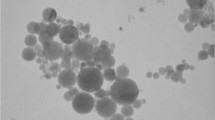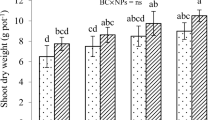Abstract
A soil microcosm study was performed to examine the impacts of cerium oxide nanoparticles (nCeO2) on the physiology, productivity, and macromolecular composition of barley (Hordeum vulgare L.). The plants were cultivated in soil treated with nCeO2 at 0, 125, 250, and 500 mg kg−1 (control, nCeO2-L, nCeO2-M, and nCeO2-H, respectively). Accumulation of Ce in leaves/grains and its effects on plant stress and nutrient loading were analyzed. The data revealed that nCeO2-H promoted plant development resulting in 331 % increase in shoot biomass compared with the control. nCeO2 treatment modified the stress levels in leaves without apparent signs of toxicity. However, plants exposed to nCeO2-H treatment did not form grains. Compared with control, nCeO2-M enhanced grain Ce accumulation by as much as 294 % which was accompanied by remarkable increases in P, K, Ca, Mg, S, Fe, Zn, Cu, and Al. Likewise, nCeO2-M enhanced the methionine, aspartic acid, threonine, tyrosine, arginine, and linolenic acid contents in the grains by up to 617, 31, 58, 141, 378, and 2.47 % respectively, compared with the rest of the treatments. The findings illustrate the beneficial and harmful effects of nanoceria in barley.

ᅟ

Similar content being viewed by others
References
Anjum FM, Ahmad I, Butt MS, Sheikh MA, Pasha I (2005) Amino acid composition of spring wheats and losses of lysine during chapati baking. J Food Compos Anal 18:523–532
Asekova S, Chae JH, Ha BK, Dhakal KH, Chung G, Shannon JG, Lee JD (2014) Stability of elevated a-linolenic acid derived from wild soybean (Glycine soja Sieb. & Zucc.) across environments. Euphytica 195:409–418
Cornelis G, Ryan B, McLaughlin MJ, Kirby JK, Beak D, Chittleborough D (2011) Solubility and batch retention of CeO2 nanoparticles in soils. Environ Sci Technol 45:2777–2782
Dimkpa CO, Zeng J, McLean JE, Britt DW, Zhan J, Anderson AJ (2012) Production of indole-3-acetic acid via the indole-3-acetamide pathway, in the plant-beneficial bacterium Pseudomonas chlororaphis O6 is inhibited by ZnO nanoparticles but enhanced by CuO nanoparticles. Appl Environ Microbiol 78:1404–1410
FAOSTAT. Food and Agriculture Organization of the United Nations. http://faostat.fao.org/site/339/default.aspx. Accessed October 2013
Gardea-Torresdey JL, Rico CM, White JC (2014) Trophic transfer, transformation, and impact of engineered nanomaterials in terrestrial environments. Environ Sci Technol 48:2526–2540
Graham RD, Stangoulis JCR (2003) Trace element uptake and distribution in plants. J Nutr 133:1502S–1505S
He Y, Wang H, Qian B, McConkey B, DePauw R (2012) How early can the seeding dates of spring wheat be under current and future climate in Saskatchewan, Canada? PLoS One 7:e45153
Keller AA, Wang H, Zhou D, Lenihan HS, Cherr G, Cardinale BJ, Miller R, Ji Z (2010) Stability and aggregation of metal oxide nanoparticles in natural aqueous media. Environ Sci Technol 344:1962–1967
Keller A, McFerran S, Lazareva A, Suh S (2013) Global life cycle releases of engineered nanomaterials. J Nanopart Res 15:1692–1709
Koehler P, Wieser H (2013) Chemistry of cereal grains. In: Gobbetti M, Ganzle M (eds) Handbook on sourdough biotechnology. Springer Science, New York, pp 11–45
Kramer U, Cotter-Howells JD, Charnock JM, Baker AJM, Smith JAC (1996) Free histidine as a metal chelator in plants that accumulate nickel. Nature 379:635–638
Lutts S, Kinet JM, Bouharmont J (1996) NaCl-induced senescence in leaves of rice (Oryza sativa L.) cultivar differing in salinity resistance. Ann Bot-Lond 78:389–398
Majumdar S, Peralta-Videa JR, Bandyopadhyay S, Castillo-Michel H, Hernandez JA, Sahi S, Gardea-Torresdey JL (2014) Exposure of cerium oxide nanoparticles to kidney bean shows disturbance in the plant defense mechanisms. J Hazard Mat 278:279–287
Mandeh M, Omidi M, Rahaie M (2012) In vitro influences of TiO2 nanoparticles on barley (Hordeum vulgare L.) tissue culture. Biol Trace Elem Res 150:376–380
Morandini P (2009) Rethinking metabolic control. Plant Sci 176:441–45
Munzuroglu O, Gur N (2000) The effects of heavy metals on the pollen germination and pollen tube growth of apples (Malus sylvestris Miller cv. Golden). Turk J Biol 24:677–684
Navarri-Izzo F, Izzo R, Quartacci MF, Lorenzini G (1989) Growth and solute leakage in Hordeum vulgare exposed to long-term fumigation with low concentrations of SO2. Physiol Plant 76:445–450
Palmgren MG, Clemens S, Williams LE, Kramer U, Borg S, Schjorring JK, Sanders D (2008) Zinc biofortification of cereals: problems and solutions. Trends Plant Sci 13:464–473
Pineros M, Tester M (1997) Calcium channels in higher plant cells: selectivity, regulation and pharmacology. J Exp Bot 48:551–557
Priester JH, Ge Y, Mielke RE, Horst AM, Cole Moritz S, Espinosa K, Gelb J, Walker SL, Nisbet RM, An YJ, Schimel JP, Palmer RG, Hernandez-Viezcas JA, Zhao L, Gardea-Torresdey JL, Holden PA (2012) Soybean susceptibility to manufactured nanomaterials: evidence for food quality and soil fertility interruption. Proc Natl Acad Sci U S A 109:E2451–E2456
Reed K, Cormack A, Kulkarni A, Mayton M, Sayle D, Klaessig F, Stadler B (2014) Exploring the properties and applications of nanoceria: is there still plenty of room at the bottom? Environ Sci: Nano 1:390–405
Rico CM, Hong J, Morales MI, Zhao L, Barrios AC, Zhang JY, Peralta-Videa JR, Gardea-Torresdey JL (2013a) Effect of cerium oxide nanoparticles on rice: a study involving the antioxidant defense system and in vivo fluorescence imaging. Environ Sci Technol 47:5635–5642
Rico CM, Morales MI, Barrios AC, McCreary R, Hong J, Lee WY, Nunez J, Peralta-Videa JR, Gardea-Torresdey JL (2013b) Effect of cerium oxide nanoparticles on the quality of rice (Oryza sativa L.) grains. J Agric Food Chem 61:11278–11285
Rico CM, Lee SC, Rubenecia R, Mukherjee A, Hong J, Peralta-Videa JR, Gardea-Torresdey JL (2014) Cerium oxide nanoparticles impact yield and modify nutritional parameters in wheat (Triticum aestivum L.). J Agric Food Chem 62:9669–9675
Shaw KA, Ghosh S, Kalaji HM, Bosa K, Brestic M, Zivcak M, Hossain Z (2014) Nano-CuO stress induced modulation of antioxidative defense and photosynthetic performance of syrian barley (Hordeum vulgare L.). Environ Exp Bot 102:37–47
Wang Q, Ma XM, Zhang W, Pei HC, Chen YS (2012) The impact of cerium oxide nanoparticles on tomato (Solanum lycopersicum L.) and its implications for food safety. Metallomics 4:1105–1112
White PJ, Broadley MR (2009) Biofortification of crops with seven mineral elements often lacking in human diets – iron, zinc, copper, calcium, magnesium, selenium and iodine. New Phytol 182:49–84
Yoon SJ, Kwak JI, Lee WM, Holden PA, An YJ (2013) Zinc oxide nanoparticles delay soybean development: a standard soil microcosm study. Ecotox Environ Safe. doi:10.1016/j.ecoenv.2013.10.014i
Yoshida S, Forno DA, Cock JH, Gomez KA (1976) Laboratory manual for physiological studies of rice. IRRI, Philippines
Zhao L, Sun Y, Hernandez-Viezcas JA, Servin AD, Hong J, Niu G, Peralta-Videa JR, Duarte-Gardea M, Gardea-Torresdey JL (2013) Influence of CeO2 and ZnO nanoparticles on cucumber physiological markers and bioaccumulation of Ce and Zn: a life cycle study. J Agric Food Chem 61:11945–11951
Acknowledgments
This material is based upon work supported by the National Science Foundation and the Environmental Protection Agency under Cooperative Agreement Number DBI-0830117. Any opinions, findings, and conclusions or recommendations expressed in this material are those of the author(s) and do not necessarily reflect the views of the National Science Foundation or the Environmental Protection Agency. This work has not been subjected to EPA review and no official endorsement should be inferred. This work was supported by Grant 2G12MD007592 from the National Institutes on Minority Health and Health Disparities (NIMHD), a component of the National Institutes of Health (NIH). The authors also acknowledge the USDA grant number 2011-38422-30835 and the NSF grant No. CHE-0840525. J. G.-T. acknowledges the Dudley family for the Endowed Research Professorship, the Academy of Applied Science/US Army REAP program at UTEP, grant No. W11NF-10-2-0076, sub-grant 13–7. Authors also acknowledge Dr. Brad Brown of University of Idaho who provided the barley seeds.
Author information
Authors and Affiliations
Corresponding author
Additional information
Responsible editor: Elena Maestri
Electronic supplementary material
Below is the link to the electronic supplementary material.
ESM 1
Description of methods, data on fertilization and soluble protein, and references on nanomaterials toxicity in cereals. This information is available free of charge via the Internet at http://rsc.org/metallomics. (DOC 70 kb)
Rights and permissions
About this article
Cite this article
Rico, C.M., Barrios, A.C., Tan, W. et al. Physiological and biochemical response of soil-grown barley (Hordeum vulgare L.) to cerium oxide nanoparticles. Environ Sci Pollut Res 22, 10551–10558 (2015). https://doi.org/10.1007/s11356-015-4243-y
Received:
Accepted:
Published:
Issue Date:
DOI: https://doi.org/10.1007/s11356-015-4243-y




